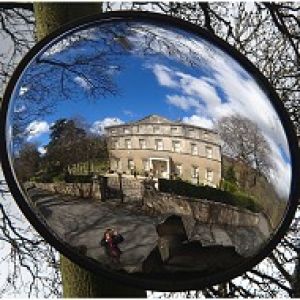Lartigue Monorail switching tracks
Back blip:
We drove down to Listowel, rather than catching rh ferry across the Shannon, because it only sails once an hour. At first I was disappointed, but the Shannon estuary way is a delight. Less mountainous than driving along Loch Etive side on the Twynuilt shore in Argyll, Scotland, but not dissimilar. Clear, still water. Small towns. A couple of factories (Bauxite processing and aluminium). A deep water harbour at Foynes.
At Listowel we apparently woke up the crew at the station. It was about 10.45. They then showed us a short series of "fillums" about the Lartigue monorail. It was built in 1887-88, took only six months, cost a third of the amount needed to build a flatbed track, and ran for 9km to the seaside town and golf course at Ballybunion. Freight, including sand and livestock, was also carried. Passengers sat in carriages facing outwards on either side of the rail, and the weight had to be evenly balanced. For example, if one were taking a cow to market to sell, one would take a cow in one carriage and two calves in the opposite carriage. Returning minus the cow, one would position a calf on either side. Or maybe sacks of potatoes, if calves were not available.
Drawbridges, or flying bridges, were used instead of level crossings. These could be operated at will by members of the public, who had right of way.
They were wide enough to accommodate a donkey cart. The railway ran until 1924, when the IRA targeted it during the Irish Civil war. A conventional railway also ran from Listowel, but not to Ballybunion, I think. This was discontinued in the 1970s. We saw footage of the final freight journey. The track was taken up in the 1980s and sold to s Sudanese railway.
We undertook a short journey in the replica train, which was built in the late 1990s/ early 2000s with millennium grant funding. It has a diesel engine, whereas the original was steam powered, with two boilers and two fireboxes ( it was nicknamed 'the coffee pot' because of the boilers). The train runs on A-frame trestles, and at either end of the rail is a a set of switches. Each complete revolution of the train requires eleven switch manoeuvres. Switches are hand-pushed by two men. One can see why this might be hard work.....I did wish I'd had a small boy or two with me. When they're in their Thomas the Tank Engine phase, around 3-4 years old, they'd go wild for this!
Charles Lartigue's monorail oroject France failed, but apparently there's also a monorail in Wuppertal, Germany. I haven't got a technical bone in my body, but I do love engineering, especially the Heath Robinson and I K. Brunel type: ridiculous to sublime.
After this visit (we didn't have time to visit the Kerry writers' museum, which id have liked) we returned to Foynes, to the flying boat museum. After the lunch which I did not partake of (glutinous soup and sandwiches at 10 Euros a head), we had a short demo of Irish coffee making (yes, really; it was invented there) and then the museum tour including the replica Boeing 314 flying boat interior. I'm going to post a short video here because I have written quite a few words already! https://youtu.be/J_YRtvme4v0
Lived the visit, having never even heard of flying boats before. When I was younger, Jet Engines were the latest thing, and the development of Concorde. I also enjoyed the section of the museum that was devoted to maritime history.
Returning to the hotel, I braved the walk to Shannon town centre after dinner. It looks as if it was built out of cardboard boxes, and concrete, Soviet-style, to house the airport workers. Shannon airport became fully functional for transatlantic flights in 1945, and the seaplanes passed into history.

Comments
Sign in or get an account to comment.


